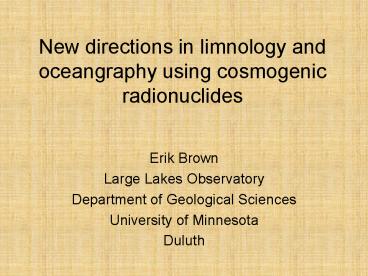New directions in limnology and oceangraphy using cosmogenic radionuclides - PowerPoint PPT Presentation
1 / 24
Title:
New directions in limnology and oceangraphy using cosmogenic radionuclides
Description:
New directions in limnology and oceangraphy using cosmogenic radionuclides Erik Brown Large Lakes Observatory Department of Geological Sciences – PowerPoint PPT presentation
Number of Views:180
Avg rating:3.0/5.0
Title: New directions in limnology and oceangraphy using cosmogenic radionuclides
1
New directions in limnology and oceangraphy using
cosmogenic radionuclides
- Erik Brown
- Large Lakes Observatory
- Department of Geological Sciences
- University of Minnesota
- Duluth
2
Cosmic ray interaction on Earth
Cosmic radiation High energy subatomic
particles Nuclear interactions with
matter Produces cosmogenic nuclides
10Be, 14C, 36Cl, 3He, 32P, 33P Cosmogenic
nuclide production Atmosphere
(mostly) Earths surface Decreases
exponentially 10x higher at 4500m than at
sealevel 2x lower 40 cm into rock than at
surface
3
(No Transcript)
4
Radiocarbon Accelerator Mass Spectrometry (AMS)
has become the method of choice. Sample size 1
mg. High precision until uncertainty in
instrument background becomes significant,
typically for materials older than 40,000
years. b-counting. Requires larger samples (4
g), but can provide good precision in older
samples.
5
(No Transcript)
6
Where is this useful?? 40 ka gt age gt 80
ka. Large samples available ( grams of
carbon)
Ancient coral. Calibration of radiocarbon
timescale.
7
Typically U-series dates
8
Biological productivity in Lake
Superior Limited by phosphate
availability Knowledge of P cycling is key
to understanding ecosystem Cosmogenic P
isotopes have been used in marine systsms. C.
Benitez-Nelson (U. South Carolina)
9
32P, 33P formed by spallation reactions in the
atmosphere
- 32P t½ 14.3 d
- 33P t½ 25 d
- 32P/ 33P t½ 33.4 d
- Advantages
- P is a nutrient used by all living organisms.
- Radioisotope half-lives relevant to biological
timescales. - In-situ tracers avoid issues associated with
bottle effects. - Ratio of isotopes minimizes changes due to
dilution. - Disadvantages
- Large sample volumes and extensive purification
- 5 tons per sample!!! Several hour shiptime.
10
Background 32P t½ 14.3 days Emax 1.71 MeV
Strong Beta Emitter. Gas proportional counter
with background count rates of 0.18-0.20
cpm 33P t½ 25. 3 days Emax 0.249 MeV
Weak Beta Emitter. Suffers from high self
absorption and cant separate from stable P.
Requires measurement with LSS counter with
typical backgrounds of 0.85 1.25 cpm depending
on quench levels 32P and 33P activities in RAIN
water 0.5 to 4 dpm/L Fluxes (dependent on
rain) Range from 800 to 2000 dpm/m2/y 32P and
33P activities in Seawater 0.5 4.0 dpm/1000 L
32P and 33P activities in particles 0.05
0.4 dpm/1000 L
11
Atmospheric Deposition
33P/32P ratio avoids complications with changes
in flux.
32P, 33P
Phytoplankton
HPO42-
CO2
Bacteria
DOP
Zooplankton
Heterotrophic Protozoa
Sinking Particles
Upwelling of Inorganic Nutrients
12
Increasing Age
All errors are 2s
13
33P/32P 1.4
33P/32P 1.15
33P/32P 0.82
33P/32P 1.05
33P/32P 0.95
H2PO4
H2PO4 DOP
H2PO4 DOP Part. P
H2PO4 DOP Part. P
H2PO4 DOP Part. P
33P/32P ratios in dissolved and particulate P
result from the source ratio (i.e. you are what
you eat) and the P residence time.
14
60 days
Increasing Age
30 days
All errors are 2s
15
Phosphate
Dissolved Organic P
Total Diss. P Low 33P/32P Ratio
Rapid Turnover Low 33P/32P Ratio
Large molecules Slow Turnover High 33P/32P
Ratio
Small molecules Rapid Turnover Low 33P/32P
Ratio
Total Diss. P High 33P/32P Ratio
Rapid Turnover Low 33P/32P Ratio
Large molecules Slow Turnover High 33P/32P
Ratio
16
Conclusions A range of questions in ocean/lake
science can be addressed using cosmogenic
nuclides. Radiocarbon dating for large samples
older than 40 kyr can provide important
complement to AMS, if 14C12C background is
lt10-16. Many major questions regarding P-cycling
(and hence overall marine or lake productivity)
remain unresolved. Some of these can be
addressed using cosmogenic P isotopes, but
present approaches limit sampling. Decreasing
background can reduce sampling requirements
5-fold, permitting more innovation in field
strategies.
17
Note that the residence time of P INCREASES with
increasing primary production. This is not
intuitive. One might expect that as more
organisms grow and consume nutrients that the
residence time of P within the dissolved phase
would DECREASE. The Increase appears to be due
to the different forms of P in the water. The
more bioaviable, low 33P/32P ratio compounds are
being consumed first, leaving the older, higher
33P/32P compounds in solution. Combined, this
causes an INCREASE in the 33P/32P ratio in the
dissolved phase. The particle 33P/32P ratios are
always low, supporting this theory.
18
(No Transcript)
19
Lake Superior Extremely low soluble reactive
P Low productivity, mostly limited by P (but
also by Fe) Annual input of P supplies less than
10 of that required for biological
activity Bacteria play a major role
20
Increasing Age
30 days
All errors are 2s
21
Rain at Sta. ALOHA 33P/32P 0.55 ? 0.19
Short Residence Time
Long Residence Time
High Bioavailability
Low Bioavailability
Normal Growth
P-Stressed
P-Starved
Bacteria and Algae
Bjorkman and Karl (2003) measured SRP turnover
rates 10 - 14 days BAP turnover
rates 4 - 21 days PP turnover
rates lt 2 - 10 days
22
- This work suggests two important points
- Open ocean organisms are responding rapidly to
their environment, and in times of stress will
consume both inorganic and organic P REGARDLESS
of the inorganic P present in the system. - Particulate P has a surprisingly short residence
time regardless of the P source in the upper ocean
Wouldnt it be nice to do this on volumes less
than 5000 L and collect samples over both depth
and region? Reducing background by 10x will
reduce sample volume requirements to 1000L.
23
Increasing Age
All errors are 2s
24
- If there is abundant sample material, b-counting
can provide better precision than AMS for samples
older than 40ka - There is a diminishing return for reducing
background































